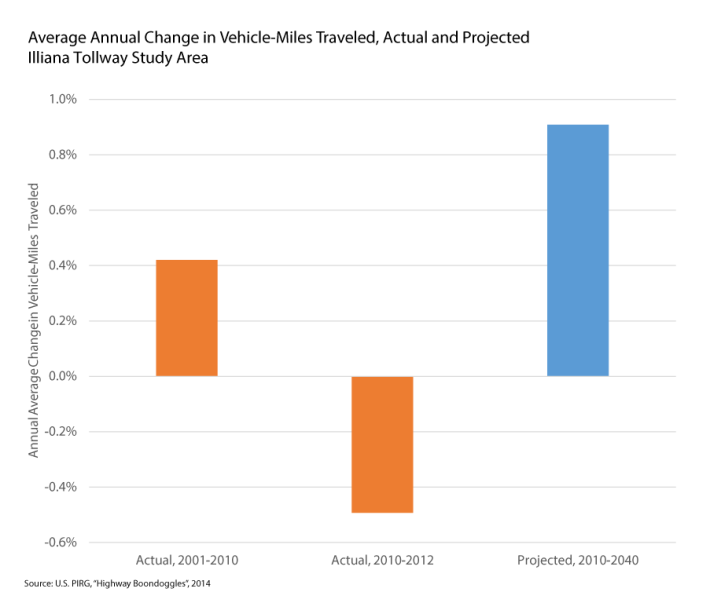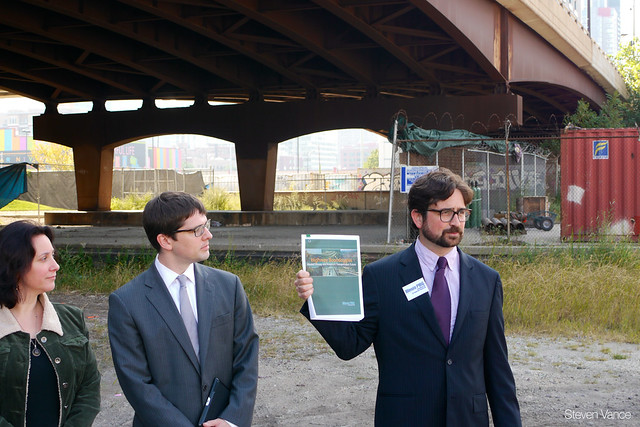
After appointees loyal to Governor Pat Quinn muscled the Illiana tollway onto the project list for Chicagoland's regional plan, it looked like nothing could stop this risky highway boondoggle from getting funded and built. The Illiana may still happen, but not without a fight.
Last week, the board of the Chicago Metropolitan Agency for Planning discussed how to kick the Illiana Tollway out of the regional plan. The CMAP Board and the CMAP MPO Policy committee will hold a joint meeting on October 8 to approve the update to the GO TO 2040 plan that includes the Illiana. CMAP must list any big transportation on the plan before any agency can build it.
Board chair Gerald Bennett, mayor of Palos Hills, asked whether board members could make a motion to excise the Illiana from the plan update before it's approved. CMAP Executive Director Randy Blankenhorn assured them they can do so.
Erica Dodt of the Sierra Club told Streetsblog that Bennett plans to ask for this motion next month. There are many good reasons CMAP should leave the Illiana perpetually on the drawing board.
According to a CMAP staff analysis released last year, the Illiana Tollway will need an enormous, $250 million startup subsidy from taxpayers. Agency staff also said the project is contrary to GO TO 2040's focus of making infrastructure investments in already developed areas.
Yet the same flaws in CMAP governance that let the Illiana corrupt the regional plan in the first place could crop up again. CMAP's MPO Policy committee voted to include the Illiana last year, in a 11-8 vote where Pace and Metra representatives cast decisive votes, going against the interests of their own riders. Right now there's a lawsuit challenging this decision, alleging that the policy committee didn't follow state law. According to the Environmental Law & Policy Center, the policy committee cannot vote on what the CMAP board has not approved.
To remove the Illiana from the regional plan, Bennett asked for another member to motion for the MPO Policy committee to adhere to the same supermajority rule as the CMAP board. The board requires a three quarters majority to approve a project. By that rule, the policy committee would need a 15-4 vote (or a 14-5 vote, if they are allowed to round down).
Stacy Myers of Openlands spoke against the Illiana Tollway last week. She told Streetsblog that the supermajority rule is to "help cure the rift between CMAP Board and MPO Policy committee decisions."
Peter Skosey, vice president of Metropolitan Planning Council, said this discrepancy should not be permitted. "The charge of the policy committee...is to program transportation dollars," he said in his testimony to the board. "If the broader agenda of CMAP's board can be over-ruled by the narrower agenda of the policy committee then the promise of CMAP will never be fulfilled."
Skosey was referring to how the state merged land use and transportation planning agencies to create CMAP in the first place. GO TO 2040 is a comprehensive plan meant to address interrelated issues like water management and workforce development, Skosey said. It's an enormous task even without a governance structure that lets one committee overrule its own board. "In October, you’re not merely voting on the plan update," he said. "You are setting a precedent that could hinder CMAP's ability to enact a responsible, regional plan."
The Illiana now has national notoriety. U.S. Public Interest Research Group listed it in a new national report about 11 highway boondoggles [PDF]. The authors cite CMAP's conclusion that the highway would expose Illinois to "extensive financial risk."

Standing beneath the structurally deficient Halsted Street bridge this morning, Abe Scarr of Illinois PIRG said that "traffic engineers continue to base the rationale for new roads on outdated and obsolete assumptions," despite data that shows people are driving less. "Illiana planners have not woken up to these changes," Scarr said.
Driving mileage in the 18-county region has gone down 0.49 percent annually since 2010, but IDOT is projecting 0.92 percent annual growth. Scarr called for the state to invest in maintaining infrastructure, adding that there are 2,274 other structurally deficient bridges in Illinois.
If IDOT and Governor Quinn separated politics from planning, U.S. PIRG wrote, they'd see the Illiana would have a "negligible impact on regional transportation performance."





